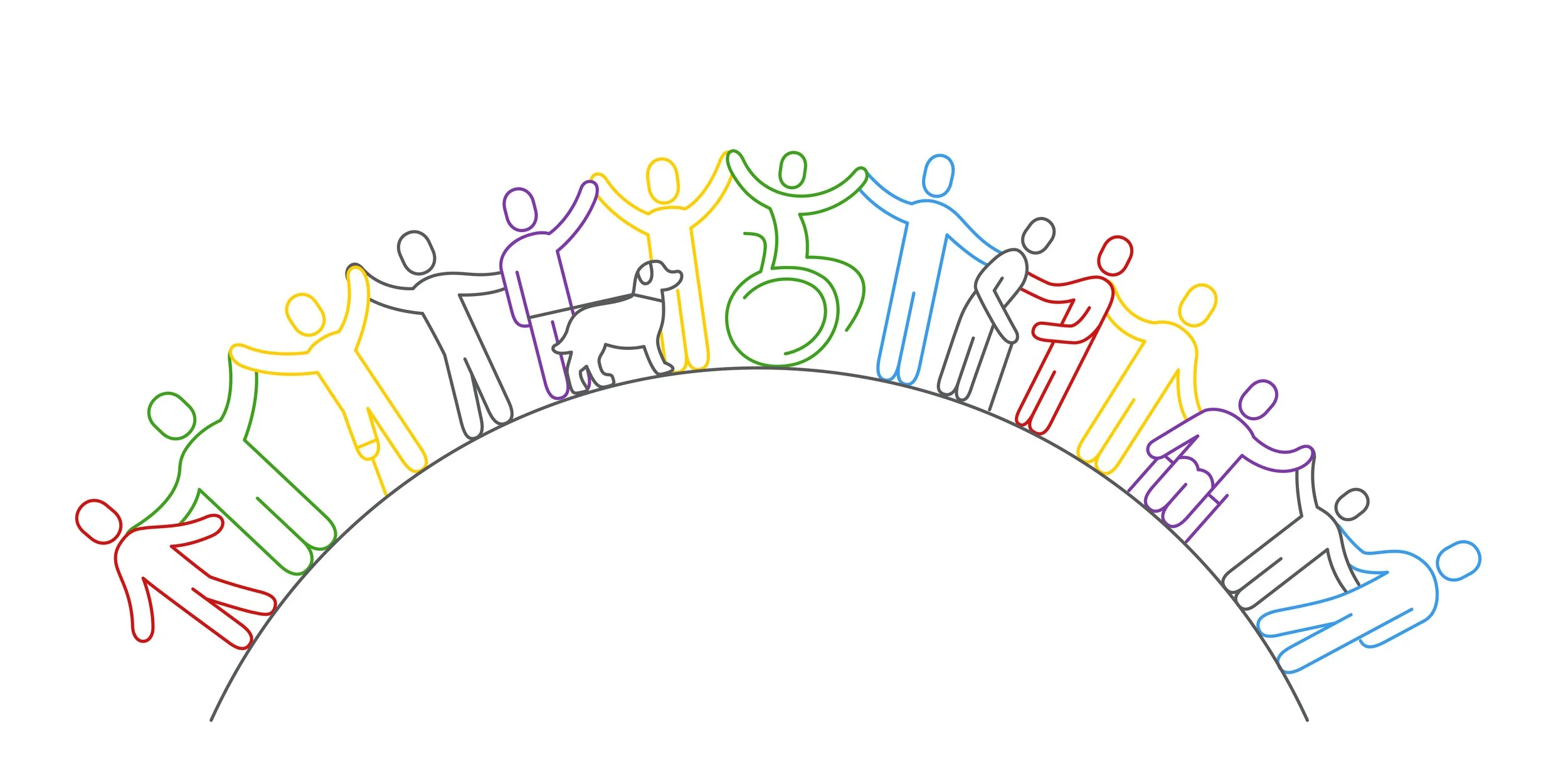When I hear someone say “DEI,” my mind jumps to HR departments, from countering bias in the hiring process to increasing retention of diverse employees. However, the focus on DEI should go beyond HR—after all, humans constitute every department in the workplace. From Procurement to Marketing, there are always people behind decisions, and for that reason, DEI is crucial across the board in organizations. Today, then, I will be exploring a variety of tips and tricks for departments beyond HR to implement DEI in their daily practices. Although this list is not comprehensive in covering all DEI possibilities for every non-HR department, I hope it offers us a strong place to start when considering the value of DEI beyond Human Resources. What are we waiting for? Let’s dive in!
Marketing & Sales
With practiced ease, Penelope slides from her wheelchair onto the couch, her friend Margot sitting beside her. She turns the TV on, catching the end of a commercial for their local grocery store. Penelope sighs.
“What’s wrong?” Margot asks, concerned.
“I don’t know. It’s just…” Penelope gestures to the TV, where the people in the ad walk around the store with bright smiles. She then motions to her wheelchair resting beside her. “That’s not how I would experience the store, you know?”
Marketing and Sales is one of the most important departments to consider the role of DEI in. As this example illustrates, when people don’t see themselves represented by an organization, they often become disconnected from whatever is being marketed. In contrast, “90% of ads that featured a diversity strategy experienced [a] higher recall [remembrance] rate”—simply put, when people see themselves represented in marketing, they remember. As such, here are tips to implement DEI in Marketing and Sales’ departments:
Images on an organization’s website(s), social media, and other visual advertisements should reflect demographic diversity, including but not limited to people of color, women, people of different generations, people with disabilities, and the LGBTQ+ community.
Digital content should be optimized for people with disabilities. For example, websites and social media should be functional for screen readers and voice search. (Although we may think of this technological era as everyone having information at their fingertips, such is not always true for people with disabilities, because online content is often not accessible!)
Use inclusive language, such as gender-neutral pronouns (e.g. the singular “they” rather than the “universal” masculine). Avoid generalizations related to experience and avoid stereotypical language, as these implicit assumptions often exclude people unwittingly.
Have diverse sales representatives, particularly when reaching out to a local community. A good rule of thumb is that an organization’s representatives should reflect the community’s demographics! To see oneself in others is to feel seen oneself.
Highlight real stories from diverse communities. After all, “[s]torytelling is a powerful tool in marketing,” as “[e]ach customer is a unique individual with a unique story and motivation to consume a product or service.” Directly engaging and displaying the narratives of one’s customers is to better connect with the diversity inherent to every consumerbase.
Imagine if Penelope turned on the TV and saw other people in wheelchairs moving through the aisles of her local grocery store. Wouldn’t that world, a world of access for everyone, be one we’d all like to live in?
Finance & Accounting
The wage gap remains as present today as it did in the 1950s, albeit to lesser severity. Women working full time are still paid on average “just 83 cents to every dollar earned by men,” and the numbers are even lower for Black and Latina women. As such, the importance of DEI within Finance and Accounting departments cannot be overstated. Let’s walk through a few ways to implement DEI through various financial operations:
Conduct a pay audit to improve pay equity, just like in the example. After all, you can’t fix a problem you aren’t aware of! Are people of particular demographics being paid less overall? If so, why? Is there an imbalance in promotion opportunities for people of majority versus minority groups? In the vein of the above example, are some people getting paid significantly less for doing effectively the same job as another person?
When compiling the annual financial report for shareholders, include a section about demographics, DEI statistics related to pay, and so forth. To do so is not only to ensure financial information regarding DEI is being monitored, but also to demonstrate to shareholders the significance of DEI to the organization as a whole.
Post pay ranges/pay rates in job postings and internally for prospective candidates and current employees to see. Not only will this help maintain pay equity through informational transparency, but to not be open about this information may give the wrong impression, as candidates may wonder if the choice not to be open about pay rates is because an organization has inequity they seek to hide.
Although most organizations no longer pay monthly, it is nonetheless important to emphasize that “[w]eekly or biweekly payroll frequency is the most equitable pay frequency.” Many people work paycheck to paycheck, therefore minimizing the time between each paycheck offers greater financial stability for employees.
Eliminating the wage gap, is not about docking a man’s pay to put him on the same level as a woman. It’s about recognizing when two people are doing similar amounts of labor to near-identical ends and compensating them fairly for that work!
Procurement
A Chief Procurement Officer sits at their desk, examining a lengthy list of potential suppliers. Numerous studies suggest that supplier diversity enhances innovation, expands access to new demographics, and improves flexibility, but where to begin?
Fortunately, implementing DEI into Procurement is not as intimidating a task as it sounds, hand over my heart! Here are a few tips for incorporating DEI strategies to improve supplier diversity:
First and foremost, identify what groups of diverse suppliers to work with on particular projects (e.g. women, people of color, veterans, people with disabilities, etc.). A good rule of thumb to classify a supplier as diverse is if they are “at least 51% diverse owned” and/or if they “have a certification attesting to their diversity.”
Beyond working with diverse suppliers, it is crucial that the consideration and requirements section of an organization’s procurement policy explicitly include “guidelines for engaging diverse suppliers.” Not only does this inclusion create intra-organizational accountability for working with diverse suppliers, but it demonstrates to other corporations how this organization prioritizes DEI.
Track the following key performance indicators: “How many diverse/local/small businesses were contacted; How many of those businesses submitted an RFP; How many of those businesses won their RFP; [and] What the contracts won were worth.” Monitoring these KPIs helps ensure an organization is working equitably with all of their suppliers and not unwittingly prioritizing some over others.
Lastly, work with suppliers that similarly prioritize DEI. Just because a potential supplier is not themself diverse doesn’t mean they don’t work with diverse organizations! Create a supplier chain that emphasizes the importance of DEI.
Still unsure where to start? SupplyShift recommends that “[t]ools like supplier.io and Tealbook provide databases of suppliers (including diverse suppliers) for businesses to build new relationships with. Companies can also attend diverse supplier events or join organizations like the National Minority Supplier Development Council for resources and peer learning opportunities.” Diverse procurement is easily attainable, so long as one is willing to put in the effort for it!
Legal
Implementing DEI into legal departments may seem glaringly obvious—just have a diverse team of lawyers at hand, right? Well, while diversity on the level of one’s team is certainly crucial, the incorporation of DEI into legal affairs can expand much further!
That sounds well and good, you may be thinking, but where do I begin?
A great question! Wolkters Kluwer offers the following starting point for Chief Legal Officers: “Start by interviewing the stakeholders. Ask your attorneys how they are making their assignments. Ask law firms whether they have diversity data and are willing to report it. If not, ask why and find out how you can help them change that policy.” Completing these steps helps ground an organization’s legal department in DEI from the get-go and moreover asserts to the law firms they may potentially work with that DEI is a make-or-break factor. Beyond this start, here are a few more tips for implementing DEI into the legal aspects of one’s organization:
When outsourcing legal matters, consider the diversity of law firms and legal service providers.
Develop measurable DEI goals. When doing so, create accountability metrics for providers, such as “the implementation of a certification system for hiring and promotion.” Deloitte explains that “[o]ne example of a certification in the legal field ‘measures whether an organization has affirmatively considered at least 30% women, attorneys of color, LGBTQ+, and lawyers with disabilities for leadership and governance roles, such as equity partner promotions, formal client pitch opportunities, and senior lateral positions.’” Such certification helps ensure organizational commitment to DEI beyond HR. (Even though this type of certification is specific to the legal side of business, wouldn’t it be amazing to include such accountability for all fields?)
Gather and maintain diversity data within one’s own department as well as any law firms the organization works with. Specifically, create a dedicated staff to “continuously check on diversity information gathered and call firms to follow up where data is missing.”
As with Marketing and Sales, Finance and Accounting, and Procurement, implementing DEI strategies into Legal departments is only as challenging as we let it be. With regular monitoring of DEI metrics and an emphasis on diverse certification, maintaining an environment of diversity and inclusion is easier than ever!
Now to conclude with some general DEI best practices that apply to all departments, regardless of their organizational concentration:
Include closed captions/subtitles for virtual meetings and videos.
Demonstrate how to use pronoun options for virtual meetings, e.g. Zoom.
Through IT, offer name pronunciation audio features for virtual meetings and e-signature software.
For written content, offer audio versions; ensure there is high contrast between the text and background colors; use easy-to-read fonts (such as dyslexic-friendly typefaces); and avoid regional turns of phrases that may not be understandable to all employees.
Remember RASCI: Who is responsible (responsibility for particular tasks); accountable (accountability for particular tasks, such as having the final say); supportive (the support network, e.g. providing resources to complete a particular task); consulted (offers advice with regard to decisions); and informed (maintains communication). When it comes to DEI, RASCI helps ensure that a) diverse people have not been overlooked for projects and b) diverse people are not primarily or only placed in supportive roles (rather than having the authority of “R” and “A”). When in doubt, apply RASCI!
And there we have it—multiple ways departments beyond HR can implement DEI into their daily workings. As we can see, there’s no shortage of opportunities! No matter what department one works in, DEI will inevitably help the entire organization flourish.
Dima Ghawi is the founder of a global talent development company with a primary mission for advancing individuals in leadership. Through keynote speeches, training programs and executive coaching, Dima has empowered thousands of professionals across the globe to expand their leadership potential. In addition, she provides guidance to business executives to develop diversity, equity, and inclusion strategies and to implement a multi-year plan for advancing quality leaders from within the organization.
Reach her at DimaGhawi.com and BreakingVases.com.



























